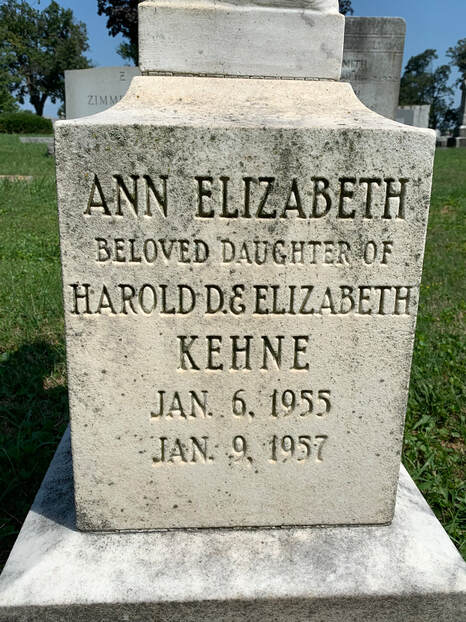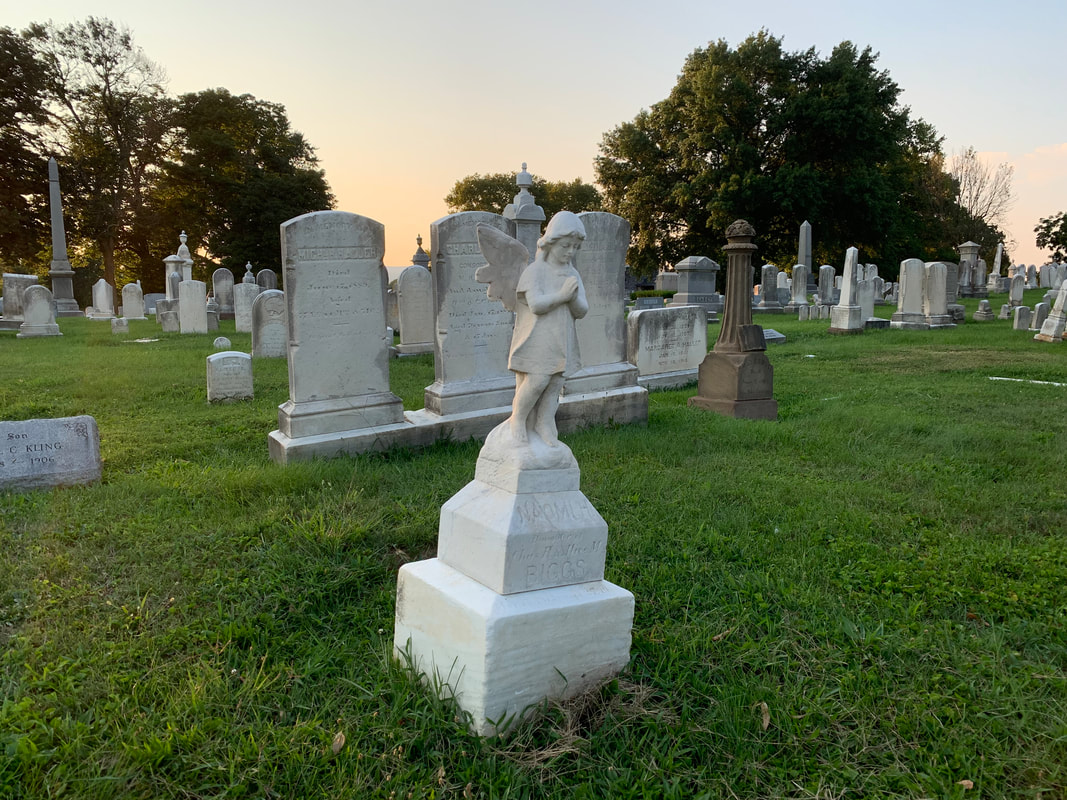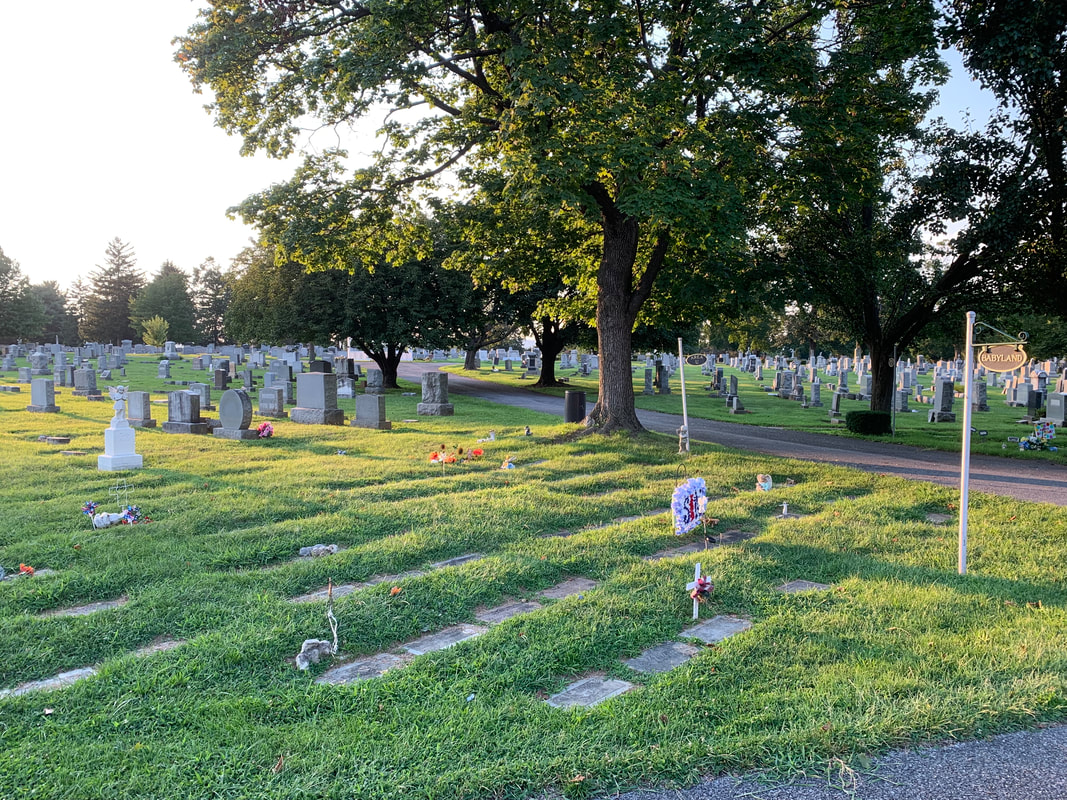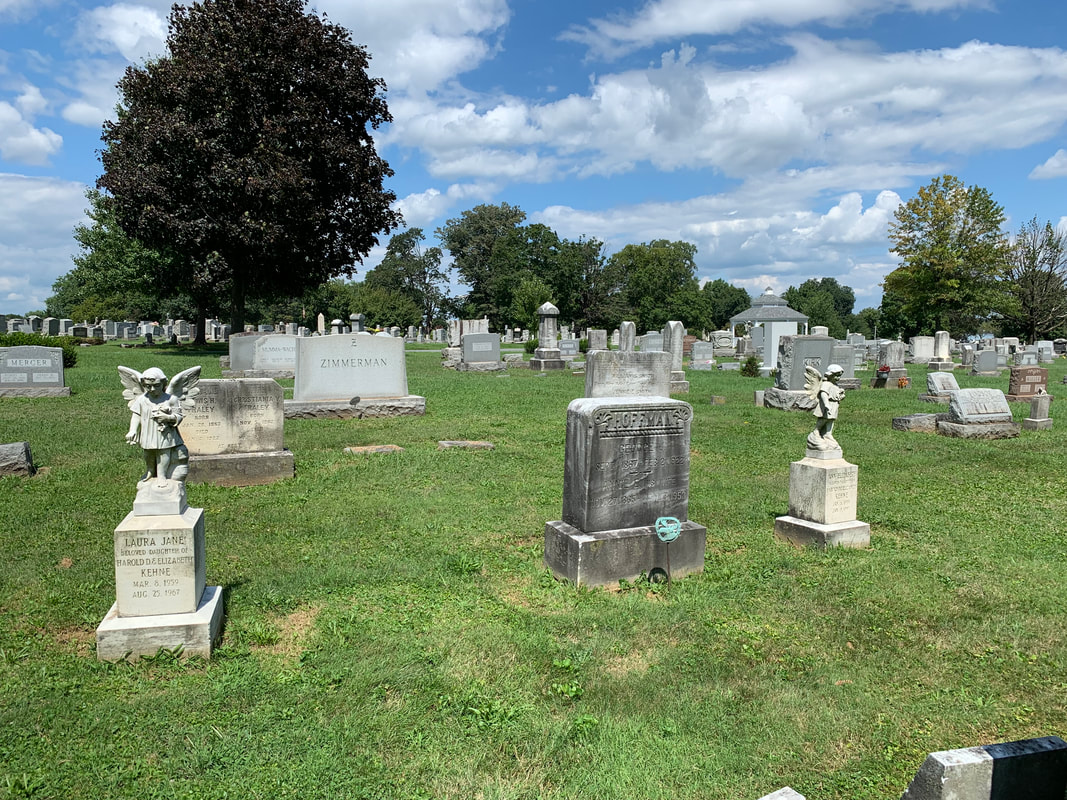|
“Angelic Bookends,” that’s what they are. These two funerary pieces can be found in Mount Olivet’s Area U/Lot 123. They mark the graves of Laura Jane and Ann Elizabeth Kehne, two sisters who died in their early youth and just a decade apart from one another. The pieces in question employ a “throwback,” or vintage, design of a cherub commonly referred to as a “child-angel.” This iconic figure from the Victorian era is a symbol of innocence and immortality. In cemeteries, monuments of this type usually denote the grave of a baby or a child. When they adorn the grave of an adult, their meaning might be more representative of the soul’s entrance into paradise than a connection to childhood. I assumed available information on these decedents would be light as these two youngsters spent a combined 14 years of existence in this world. Hopefully, someone out there reading this piece will add more about them (and the family) in the comment section (at the end of this article) as the girls’ parents have both passed within the last 20 years. The extent of information on Ann Elizabeth Kehne can be found in her obituary and funeral notice in the local newspaper from 1957. Born January 6th, 1955, Ann only attained the age of two, dying three days after her birthday on January 9th, 1957. Our cemetery records show that although the family was living in Frederick’s Monocacy Village (912 Cherokee Trail) at the time, the toddler died of encephalitis while hospitalized in Baltimore. Just over a year after Ann Elizabeth’s death, the Kehnes had reason to rejoice as they were blessed with the birth of a second daughter on March 3rd, 1958. She was given the name Laura Jane. I wasn’t expecting to find much about this youngster in the newspaper either, but I was wrong as I immediately found a photograph of her in an edition of the Frederick Post from October 17th, 1962. It shows Laura Jane undergoing ambulation therapy. For those not familiar with the term, “ambulation” is the ability to walk without the need for any kind of assistance.  The picture’s caption said that this therapy had taken place at the Frederick Easter Seals Health Center. This facility opened in 1957 and was once located at the Odd Fellows Home on North Market Street. It served not only Frederick County, but our neighboring counties as well. Now, some of our younger readers may be asking, “What is/are Easter Seals?” Easterseals (formerly known as Easter Seals) is a charity founded in 1919 as the National Society for Crippled Children. It is a 501(c)3 nonprofit organization providing disability services, with additional support areas serving veterans and military families, seniors, and caregivers. The name "Easter Seals" came from an earlier fundraising program begun in 1934 with colorful adhesive seals, the size of postage stamps being sold around Easter. Purchasers could stick these on the back of mailed envelopes, as a popular tradition was to send cards to friends and family both at Christmas and Easter seasons. Because of the program's success, the organization changed its name from "the National Society for Crippled Children" to "Easter Seals." Another photograph of little Laura had appeared a few months earlier in the Frederick newspaper. It showed Laura, with her mother (Elizabeth), receiving assistance from Frederick’s Zonta Club. I would find another at the end of 1963 with a visit from Santa. Right when I began thinking that my young subject (Laura) could have been some sort of posterchild for children with disabilities, I read the heartwarming news on January 3rd, 1964 that Laura had been named Maryland’s Easter Seal Child. An informative article appeared in March of 1964. Laura was making great progress and was a shining example and ambassador for the work the Easter Seals organization was doing. I found nothing more at hand during my cursory checks of old newspapers and the internet, save for some school class pictures appearing in newspaper. Laura would go on to attend the Visitation Academy from what I could see. Sadly, the last mention of Laura Jane Kehne came in the form of her obituary in late August of 1967. She, like her sister, died in Baltimore. This occurred on August 25th of that year at the tender age of 8. Laura would be buried a few days later in Mount Olivet, roughly five yards away from the “older” sister she never had the chance to know. A “child-angel” monument was added to mark her final resting place, just like the one that had been placed on Ann Elizabeth Kehne’s grave a decade earlier.  Visiting the sisters graves this week, I sought to learn more about the basis of these particular funerary monuments. In their online blog entitled Cemetery Insights and Beyond, authors Dave and Linda Vichiola-Coppola state that: “Cherubs appear in the Book of Genesis and are ranked as one of the highest orders of angels. As the Bible story goes, after Adam and Eve’s banishment from the garden of Eden, God stationed a cherub holding a flaming sword to guard the entrance. It was not hard for the faithful of long ago to imagine the cherubim as sentinels. The traditional image of a cherub was not cute or childlike at all. In modern times we find it difficult to envision a winged infant (or a young child) holding a flaming sword and assuming a strong stance to ward of intruders. Our perception of the cherub was changed by two important developments during the 19th Century: archaeological discoveries and a set of new social values. In the mythology of ancient Greece and Rome, the god of love was depicted as a young boy. Yet, neither the Greek god Eros or the Roman god Cupid is depicted as a baby. Lin Vertefeuille of Ringling Docents.org points out that the image of the cherub as a baby more closely resembles a nature spirit known in ancient Greek and Roman mythology as genius/genii. The same images of the winged babies appeared in masterpieces of art from the Renaissance and Baroque periods, but they were called putti (putto, singular). During the Victorian era, there was a revival of classical art sparked by major archaeological excavations that were taking place in Greece. The winged baby image of the genii decorated the artifacts that were unearthed. The image appealed to the Victorians because of its resemblance to the infant angels that were depicted in masterworks of art from the Renaissance and Baroque periods. The Coppolas go on to say, “While archaeology played a role in the cherub’s physical characteristics of the 1800’s, a growing cultural concern over the well-being of children made the cherub a popular cemetery monument. Prior to the 20th century, the death rates for children and infants were staggering. Before the time of major medical advancements, many infants died at birth and those that survived had to make it through childhood without succumbing to infectious diseases. Poverty levels in industrialized areas and the lack of child labor laws made children more prone to life-threatening health problems.” Annette Stott, a writer for the website Nineteenth Century Art-Worldwide, explains, “High mortality rates boosted the value of children….an ideal of childhood arose that stressed the natural innocence and joyfulness of children.” Advocates of child labor laws during the late 1800’s helped prompt growing social concerns over the well-being of children. The treasured values of childhood were frequently depicted in Victorian art and literature. The images of the putti that decorated the Greek artifacts resembled a baby angel, just as the Roman and Greek god(s) of love (Cupid and Eros) resembled an angel child. So, when a child died, the Victorian cherub served as an appropriate graveside symbol of innocence and youth. Today, the Victorian cherub remains a popular cemetery icon to mark the graves of children and infants. Many examples exist within the historic section of the cemetery. A more modern angel can be found close to the Kehne sister on the east side of Area U as the prime marker for a unique section called “Babyland.” I know the name catches some off guard, but this is a specific area designated for infants and toddlers. Young children of this age were originally buried in Area M, also known as “Stranger’s Row,” a charitable area where bodies of deceased visitors to town (without family elsewhere) could be buried, as well as indigent persons, or those widowing wives and orphaning children with little to no means to bury their loved one. Many infants were buried here in economical, “smaller designed” lots—helping to relieve a financial strain from families not having family plots (or planning for them in the prime of life as young adults). When photographing the Kehne “child-angel” monuments for this story, I struggled to find the girls’ parents anywhere nearby. I simply found a large family marker for the lot-holding Hoffman family. Once back in the office, our database revealed that parents Harold Dorsey Kehne and Elizabeth Eloise “Boots” (Shoemaker) Kehne were buried in Area FSK/Lot 105. This is a section to the immediate north of the Mausoleum/Office complex in the back section of Mount Olivet. This is nowhere close to Area U where Ann and Laura are located. A secondary question came to me in addition to “Who were these young “angels?” — “Why are these girls not buried with their parents in the same location?” I soon found the Hoffmans to be the maternal great-grandparents of Laura Jane and Ann Elizabeth Kehne (grandparents to the fore-mentioned Elizabeth (Shoemaker) Kehne. This took a little detective work—fitting because original lot-holder George Jacob Hoffman (b. 1868) was a Frederick City policeman. Mr. Hoffman died at age 53 at his home at 152 East South Street in 1922. He would be the first of his immediate family to be buried here in a plot shared with his great-granddaughters. George’s widow, Annie Hoffman would continue living in her home on Frederick’s southside off East South Street. This a fairly recognizable rowhouse that still stands today across from the Frederick County Public Schools headquarters building on the northwest corner of East South and South East streets. The house at #152 is the easternmost townhome here, just down from Winchester Street. Regular readers of this blog may recall that the name of this street comes from Benjamin F. Winchester who opened a brick manufactory in this vicinity. This would eventually become Frederick Brick Works. Benjamin was the brother of Hiram Winchester, a New England schoolteacher who was responsible for the Frederick Female Seminary on East Church Street in the 1840s. This is today known as Winchester Hall and serves home to our local Frederick County Government.  Shoemaker gravesite in Area FF/Lot 294 Shoemaker gravesite in Area FF/Lot 294 Back to our Kehne sisters and their great-grandmother Annie (buried between them), Mrs. Hoffman is listed as head of household in the 1930 census. Her sons worked as salesmen for a nearby ice plant operation, while her daughter, Margaret, and granddaughter, Elizabeth, also lived here. The puzzling thing for me here came in the realization that six-year-old Elizabeth Shoemaker was listed as “Elizabeth Hoffman” and that her supposed mother, Margaret Hoffman was only 11 years her senior at age 17? I thought that perhaps Margaret was simply an aunt and that there was a missing, or deceased, son of Mrs. Annie Hoffman who could be the father of Elizabeth prompting the name Hoffman here in this census record. Her mother would be missing as well. Our cemetery records did not provide me with the names of Elizabeth’s parents, however, my research assistant Marilyn Veek answered these questions for me. She showed me that George and Annie Hoffman's daughter, Margaret Laura Hoffman, married a man named Jacob Arthur Shoemaker, Sr. and that Elizabeth was the daughter of Margaret Hoffman. I checked our database and found Margaret and Jacob Arthur buried here in Mount Olivet (Area FF/Lot 294). Our records show Margaret’s birthdate as February 15th, 1904, thus proving that the 1930 census showing of her age as 17 was erroneous. She was actually 27 and plenty capable of having a six-year-old daughter in 1930. When I looked for Mr. Shoemaker in the 1930 Census, I found him also living with Margaret, but at a location around the corner at #10 Winchester Street—and they had other children too! In Ancestry.com, I found the R.L. Polk Frederick City directory from 1928-1929 that listed both Jacob and Margaret Shoemaker as living at 152 E. South Street, the former Hoffman family home. They must have moved nearby shortly thereafter. Margaret was a machine operator at a tailoring business and Jacob was an electrician with Frederic Iron and Steel Company. As an aside, I found a small article in a paper from 1916 that stated that Jacob had run away from home, but not for long. This occurred just months after the youth was “stunned” by a bolt of lightning that struck near his church in Braddock Heights. Naturally, I expected to find Elizabeth living with her mother and Mr. Shoemaker in the 1940 census. Instead, Elizabeth was still residing with her grandmother and maternal uncles on Winchester Street. Maybe the house on Winchester wasn’t big enough? Or perhaps Elizabeth got along better with her grandmother than mother, we may never know? Meanwhile, Margaret Hoffman Shoemaker can be found living at #10 Winchester Street with three children: Jane, Jacob Arthur, Jr., and Cleora. Elizabeth can be found once again living with her grandmother Hoffman in spring of 1950, and she is listed as an elementary school teacher. She had graduated from Frederick High School in 1940 and from State Teachers College at Towson in 1944. She would later earn her master's degree from University of Maryland at College Park. Just a few months after this census was taken, she would be married in the month of July in a double wedding ceremony with a younger sister named Cleora (Cleo) Shoemaker (1930-2015). Mr. Kehne was a former veteran of World War II and may be remembered for owning a gas station, Kehne’s Citgo on the corner of East and East 13th Streets, not far from his family’s home in Monocacy Village. He owned this from 1957-1974 and That station still exists today as the East Street Liberty. The Kehnes would have three children, the fore-mentioned Ann and Laura, and a son David. Harold Dorsey Kehne, age 86, of Frederick, passed away at Frederick Memorial Hospital. He was a graduate of Frederick High School (class of 1943). After selling his business, Mr. Keene attended the University of Maryland and studied education, likely inspired by his wife. He taught at Middletown High School, West Frederick Middle School, and New Market Middle School, until his retirement in 1986. A teacher for 31 years, Mrs. Kehne first taught at Emmitsburg Junior High School and at several other schools including Elm Street School and Frederick High School. When she returned to teaching after having children, she taught at Frederick Academy of the Visitation and then returned to teaching public school. An early advocate for special needs students, she started the county's physical education program at Harmony Grove School and then moved to Rock Creek School when it opened in 1972. This would lead to her election into the Alvin G. Quinn Sports Hall of Fame. Her unselfish service and belief in impaired students led her to strive for successful creation of the Frederick County Special Olympics. She coached students to numerous championships in various sports and created for her teams and students the opportunity to achieve beyond all expectations. Somewhere along the way, she picked up the nickname “Boots.” Elizabeth’s brother-in-law, Max S. Kehne, is also a member of this prestigious group of local athletes and sports pioneers recognized in the Quinn Hall of Fame (housed at the Frederick County YMCA). Max Kehne is still remembered as most famous softball pitcher in Frederick County history, and a member of the Maryland Softball Hall of Fame. He was also a key area sports promoter and a member of Frederick City Board of Aldermen at the time of his untimely death due to an automobile accident. Max S. Kehne Park on West 7th Street is named in his honor. Elizabeth S. Kehne retired in 1986. She was active in the Frederick City Recreation Council, serving for many years as the council's secretary. Following her retirement, she was a volunteer tutor with the Literacy Council of Frederick and enjoyed spending time with family and friends in Frederick and in Rehoboth, Delaware. I found that surviving son David helped establish the Harold D. and Elizabeth S. Kehne Scholarship Fund in 2015 with the Community Foundation of Frederick County. The fund’s purpose is to provide scholarships to graduates of Frederick High School or Gov. Thomas Johnson High School pursuing a career in education. Preference is given but not limited to students attending Towson University, University of Maryland College Park, or one of these educational institutions’ extension campuses. Since the fund was created, it has helped students pursue careers in education just as the Kehnes did. So, there it is. I figured out who the interesting monuments in Area U were “bookending,” so far from the gravesite of their educator parents. I had become intrigued with Elizabeth’s challenges throughout her life. Her resilience as evidenced by her educational pursuits and achievement are evident that she persevered despite any initial setbacks. I will say that knowing this information about Elizabeth’s childhood and professional career, certainly makes me respect her even more knowing that she lost Ann Elizabeth at such an early age, and was forced to endure the incredible stress of having Laura and working so dutifully as a mother with assisting her daughter in the everyday challenges revolving around disabilities. As we know, this would end with Laura’s untimely death as well. I never knew Elizabeth Eloise (Shoemaker) Kehne, but when I visited her gravesite here in Mount Olivet, several hundred yards from that of her daughters, I thought to myself that perhaps there should be one more “child-angel” monument placed here on her grave as well.
0 Comments
Leave a Reply. |
STORIES
|
Archives
July 2024
June 2024
May 2024
April 2024
March 2024
February 2024
January 2024
December 2023
November 2023
September 2023
August 2023
July 2023
June 2023
May 2023
April 2023
March 2023
February 2023
January 2023
December 2022
November 2022
October 2022
September 2022
August 2022
July 2022
June 2022
May 2022
April 2022
March 2022
February 2022
January 2022
December 2021
November 2021
October 2021
September 2021
August 2021
July 2021
June 2021
May 2021
April 2021
March 2021
February 2021
January 2021
December 2020
November 2020
October 2020
September 2020
August 2020
July 2020
June 2020
May 2020
April 2020
March 2020
February 2020
January 2020
December 2019
November 2019
October 2019
September 2019
August 2019
July 2019
June 2019
May 2019
April 2019
March 2019
February 2019
January 2019
December 2018
November 2018
October 2018
September 2018
August 2018
July 2018
June 2018
May 2018
April 2018
March 2018
February 2018
January 2018
December 2017
November 2017
October 2017
September 2017
August 2017
July 2017
June 2017
May 2017
April 2017
March 2017
February 2017
January 2017
December 2016
November 2016

















































 RSS Feed
RSS Feed